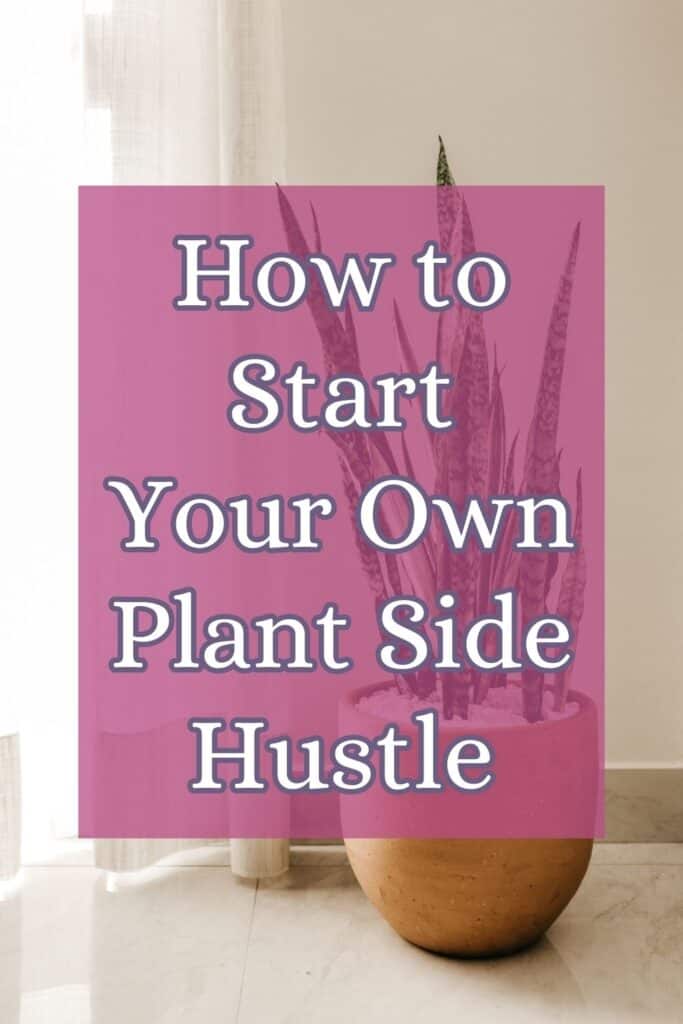Easy Ways to Make Money With Plants
Are you a plant mom with an overflow of plant babies? Or maybe you're simply a plant enthusiast that needs a justification to buy yes, another, plant.
Ready to turn your green thumb into green dolla dolla bills, y'all? Here are a few easy ways to make money with plants.
You will need:
- indoor houseplants
- a few extra pots
- soil
This botanical side hustle is not entirely passive as you do have to care for the plants and arrange pickups, but it isn't time-intensive or trading dollars for hours, either. If you already have a variety of houseplants you could realistically start making money from plants as soon as this weekend!
This side hustle to make money with plants is for you if: you already have plants that you prune or cut back on a regular basis, if you have a decent knowledge base about plant care, and if you need a side hustle with loads of flexibility. If you don't have plants already, that's okay… you can grow them! 🙂 It's a good idea to do some research first, especially if you don't have an abundance of plant babies you can adopt out right away.
Table of Contents

How Much Money Can You Make Selling Plants for Profit?
The amount of money you can get from selling plants will vary. The type of plant you are selling, as well as if it is a whole plant or a rooted cutting, will impact your profits. Startup costs are very low, though, so your profit margin should be quite high.
For example, if you already have an aloe plant, you can easily propagate it and sell the little baby aloes for $5 a piece. You'll have a bit of expense with the potting soil and your time, but otherwise that $5 is almost all profit.
If you already have houseplants that you prune, cut back, or divide, then you are ready to make some cash. Depending on what you have, and how many cuttings you can take, you could easily make $50-200 your very first weekend.
Selling plant cuttings is fairly popular; there's even a guide for learning how to grow plants to sell.
What are the Startup Costs for Selling Houseplants?
Selling indoor plants is a great side gig. If you are already a houseplant connoisseur, you can use your existing collection to propagate new plants and sell them. If you don't have any houseplants, you will need to purchase some to start with – as well as other supplies.
Sourcing materials such as pots, soil, fertilizers, and other necessary supplies can get expensive – so set a budget ahead of time.
The costs will vary from region to region, and even city to city. If you upcycle thrifted pots and make your own soil with leftovers from a friend's farm, your profit margins are going to be much higher.
One tip I wish someone would've shared with me when I first got into business: just because you get something on sale doesn't mean you pass that sale along to your customers. Your profit margins should include the supplies at full price because there won't always be a sale!

How to Make Money With Plants
The idea of selling houseplants for a side income is to have one mother plant and then sell the babies or rooted cuttings. This turns each plant into its own money tree. 😉
You will also need small containers and potting soil to get started. Most plants should be kept in natural light. If you don't have a good window, then you will need to buy a grow light. The best way though is with natural light.
If you want to sell your plants as gifts, purchase some cute planters at a wholesale cost to sell with them. This plant-with-planter combo will also yield a slightly higher profit overall.
Things to Consider Before You Start Making Money from Plants
Before you start selling your houseplant cuttings, you will want to think about a few items such as business requirements, sales area, and popular plants.
It is legal to sell plants from your home. In some states, you will need a license or permit to sell plants, cuttings or seeds. In others, you will have restrictions on types of plants or seeds you can sell. Always check with your state government authority to understand these regulations in your area.
Are you going to sell locally or online? Personally, I would recommend starting locally, and on a smaller scale, so you can perfect your plant selling strategies. If you decide to sell online, however, be aware of any restrictions on selling plants to other states. For example, you cannot sell citrus to Texas, and Hawaii requires a quarantine period. It is up to you to check these regulations and maintain compliance with them.
One other consideration before you start selling rooted cuttings is your own knowledge base. Customers will have questions and want plant-growing advice. Do you understand the care needed for the plants you are selling? Can you give your customers the added value of tips for what to do if their plant isn't thriving? Do you have policies in place in case the plant dies? Spend some time writing down customer care policies so everyone gets treated fairly.

Your plant customers might also have family pets. Go the extra mile and find out if the house plants you are selling are toxic to cats or dogs. No one wants to make our four-legged friends ill!
Stock a variety of indoor houseplants that are nontoxic to pets. Many people don't realize houseplants can poison cats and dogs until it is too late. Your customers will appreciate this information.
Do you know what plants are popular in your area? Are you aware of the selling price for most houseplants? If you don't know this off the top of your head, do some research. One of the best ways to get this information is to join a local gardening group on social media.
Lastly, you will also want to be aware of local growing conditions. If you live in the desert, for example, you probably will not want to sell plants with high humidity requirements. This might be okay for advanced plant people, but beginners will get frustrated when their plants dry out and die. Choose plants to sell that will be relatively easy for beginners to grow.

Getting started: research the market.
Each local market will be a little different. Doing research before you get started will save you a lot of time, and potentially a lot of money and heartache as well. Choosing the wrong plants to sell because you didn't do any research would be a real bummer, right?
- Ask around. Are your friends, family, and neighbors buying plants? If so, ask them all the questions you have! If not, check local Facebook groups and apps like Next Door. See if people are looking for specific plants, and if the need is large enough to warrant a side hustle for you.
- Research the competition. Who is selling plants in your area? Check out local vendor fairs and farmer's markets, as well as local farm shops, to see what others are selling and at what price point. You may scope them out a few weekends in a row, just to get a feel for the flow and vibe of their stores, pricing structure, and customers.
- Don't be afraid to start small. Everyone loves to think big and dream big, but that doesn't mean you have to invest big… at least not right away! It's okay (and recommended) to dip your toes in a bit before going all in. Especially if you have ADHD and are just going to abandon this hyperfocus in 3 months.. *ehem*
What are the Best Houseplants to Sell from Home?
Once you have your customer care policies written down and basic supplies purchased – it's time to start seeing green. What are the most profitable plants to sell, though?
The first answer is to sell the ones you have. If you have houseplants already that are easy to propagate, go ahead and start selling those babies. For example, if you have a pothos plant, get out the x-acto knife and take a few cuttings to sell.
The best part about selling houseplants as a side hustle is that you will never waste the plant! You can sell unrooted cuttings, rooted cuttings, baby plants, or mature plants. If you take cuttings and they don't sell right away, you can pot them and then sell the plant itself.
Try to curate a plant collection with different behaviors and needs. For example, you will want vining plants, flowering plants, and some soft ferns. Choose plants with varying light requirements as well. You will get additional customers by having a variety on hand.
If you don't already have a house full of indoor plants, these are a few of the best sellers I've found in my research. However, this will vary from area to area so please do more research! 🙂
Some of the needier plants can be sold at a premium, but don't underestimate the profitability of common options, either. Take the time and effort to build a reputation as a seller with quality, disease-free plants. It will pay off in the end.
Snake Plant
Snake plants are a common houseplant because they are beautiful and relatively easy to grow. If you already own a snake plant, you can take cuttings or propagate by division. Just remember the colorful patterns from the parent plant will not be replicated in the cuttings. If you want to bring out the natural variations in coloring, then division is a better choice. It can take a few months to get a fully rooted new snake plant, but they are not too finicky.
Anthuriums
Anthuriums are beautiful, flowering, tropical plants. They are also toxic to pets and humans if ingested. These plants take a little more care and knowledge, so only propagate them if you have the skill level. They live about 5 years and propagation is simple. These can be a very profitable plant, selling between $30-50 for a 10-inch plant.

Variegated Monstera
If you are confused as to why a variegated monstera is worth $150 or more for a cutting (a cutting!), then are you even on Instagram? If you get lucky enough to get one of these beauties, you can make a killing. Caring for a variegated monstera is pretty simple, but propagation can be a little tricky.
There is also no guarantee the cuttings will result in the elusive variegation patterns. Once you figure out how to propagate it properly though, you can sell cuttings and fully rooted plants for literally hundreds of dollars.
String of Pearls
This dainty sweet plant is great for hanging baskets or planters. The string of pearls and its cousins, string of dolphins, string of bananas, and string of turtles, are amazingly easy to propagate.
You literally take a cutting and put it in dirt. Get the whole collection and sell them as a bundle to your customers. A single 4 inch plant can be sold for about $5 (check your local area). If you have the mother plant you can sell several cuttings off one plant.
Alocasia
There are 97 varieties of this subtropical and tropical big-leafed plant. The best method for propagation is to divide the rhizomes. Pay attention to the light requirements for alocasias, but other than that, these are pretty easy to grow. An adult plant can be sold for $40 or more, and this plant will just keep on giving as you divide the rhizomes for babies.
Succulents
There are so many varieties of succulents, and they are perfect for beginners! You can divide and sell succulents year round. They make beautiful housewarming and Mother's Day gifts. Even better – they are ridiculously easy to propagate! If you are a novice, succulents are some of the best and easiest choices to get started making money with plants. Aloes, hens and chicks, euphorbia cactus, and Christmas cactus are great starter plants!
How to Price Your Plants for Sale
Your selling price will vary depending on the plant availability as well as size. Typically, rooted cuttings will sell for more than unrooted. Potted plants will sell more than cuttings. Large potted plants will sell more than small ones.
Take your time, cost of soil, and plant investment into account when deciding on your prices. Check local greenhouses or stores to see what plants are selling for locally. If you have vibrant, healthy plants, don't be afraid to sell for a bit more than what the big box stores are selling them for. Your knowledge and personal touch are worth a few extra bucks.
How to Find Customers to Buy Plant Cuttings
Market your plant-selling business through social media (or even a blog!) to showcase your plants, share care tips, and engage with potential customers. Remember: it isn't just about selling. Yes, you want to make money… but delivering value will always draw in far more customers.
I recommend Jab, Jab, Jab, Right Hook for some light reading about marketing.
If you are open to shipping your cuttings, you can create a website and target phrases such as:
- fuchsia cuttings
- aloe vera cuttings
- dahlia cuttings
- gardening cuttings
- flowering cuttings
- basil cuttings
- and more!
Depending on your area and your set up, you may be able to create a site for local buyers only. If you live in a small town, it could be more difficult to make money with plants… but you never know how far people are willing to drive to pick up the perfect plant cuttings. 😉

Find Your Niche!
Much like with blogging, it's usually more profitable to specialize in a particular type of plant or a specific category. This could include indoor plants, succulents, rare species, or ornamental plants. Having a niche can help you stand out in a crowded market.
This doesn't mean you have to stick with one or two plants (our ADHD brains hate that shit!), but sticking with a TYPE of plant can help you increase your expertise, authoritativeness, and of course, your bottom line. $$
- Identify Your Passion and Expertise: Start by considering the types of plants that you're passionate about and knowledgeable about. Your expertise will shine through when you're able to provide in-depth information about the care, characteristics, and unique features of the plants you're selling.
- Research Market Trends: Research current market trends and consumer preferences. Are there specific types of plants that are gaining popularity? Are there certain plant varieties that are considered rare or unique? Stay attuned to what's in demand.
- Consider Target Audience: Think about the audience you want to cater to. Are you interested in selling to indoor plant enthusiasts, outdoor gardeners, or collectors of exotic plants? Tailoring your niche to a specific audience can help you tailor your marketing strategies effectively.
- Explore Unmet Needs: Look for gaps in the market where there might be unmet needs. This could be anything from offering specialized care advice to focusing on specific plant categories that are underrepresented.
- Unique Selling Proposition (USP): Define what sets your plant business apart from the competition. Your USP could be your extensive knowledge, a focus on rare and hard-to-find plants, or sustainable and eco-friendly growing practices.
- Test and Iterate: As you explore different niches, be open to testing and iterating. You might find that your initial niche evolves as you learn more about your customers and their preferences.
Remember, finding your niche isn't just about making a choice—it's about aligning your passion, expertise, and market demand to create a business that resonates with your target audience.
Whether you decide to specialize in succulents, indoor plants, or unique orchid varieties, the key is to offer something that stands out and meets the needs of plant enthusiasts in a way that others aren't quite achieving. When you get a small taste of success with your plant selling business, you can rinse and repeat it on a larger scale!
Other Profitable Plants to Sell
If you find you love making money with plants, you can start branching out beyond houseplants. This is especially easy if you already have a bit of a green thumb!

Consider selling:
- Herbs (dried, cuttings, plants)
- Lavender (dried sachets, diffusion, plants)
- Ground Covers (especially profitable in the summer season)
- Flowers (plants, seeds, bulbs, bouquets)
- Gourmet Mushrooms (yes, it's a thing!)
Where to Sell Rooted Plant Cuttings
Once you have decided what you are going to sell, you can list your plants in many places. Facebook marketplace is a great start to get local customers. You can also set up a booth at craft fairs and coffee shops. Having a website with good SEO will give you authority with the local community as well, in case you have some competition.
Contact your local botanical society and let them know you are in business. Join local gardening and houseplant groups on Facebook or other social media to make connections and offer your rooted plant cuttings or entire plants.
If you take the time to build your reputation with healthy plants and valuable tips, you can do an annual or quarterly plant sale. At the plant sale, you can showcase all your cuttings and potted plants at one time. Customers will eventually begin to recognize your name and will be putting your next sale in their calendars.
As I mentioned above, you can also sell online with your own website or Etsy. However, if you are going to invest in online selling platforms, make sure you have the stock available. If you have just a cutting or two, it is probably not worth setting everything up to sell online. When you decide to scale up, then definitely check into the online plant selling options.

Other Ideas to Get the Most out of Your Profitable Plants
There is no waste when you are making money from plants. If the cuttings don't sell right away, go ahead and plant them, and then you can sell the plants. There are several other ways to make money with your indoor houseplant side hustle.
- Sell stock photos of your Indoor or Outdoor plants.
- If you have flowering plants, dry the flowers and make laminated bookmarks or wall art.
- You can rent out small, potted succulents as centerpieces for weddings. The bride returns them when the wedding is over and then you can sell them.
- Bundle potted plants with balloons, candy or other items for gift kits. These would be popular for birthdays, Valentine's Day, Mother's Day, etc.
- Donate a few plants to local nursing homes or assisted livings just to brighten up the environment.
- Teach a class for beginners on indoor plant care, how to salvage seeds from flowers, how to make a succulent tray, or medicinal properties of plants (if you have the knowledge).
There are many ways to make money from plants that you already have. If you don't have a diverse houseplant collection, it might be worth investing in one or two rarer houseplants just so you can sell the cuttings. This is a side hustle you can easily do on the weekends or with a few spare hours.
Take care of your plant reputation by selling healthy plants and treating your customers right. Your green thumb will be paying you before you know it. I have lots of other passive income ideas here, so be sure to check them out.
Just getting started? You can use YouTube to learn things like the art of growing rosemary cuttings, or how to grow plants from cuttings, and go from there!
How to Make even MORE Money With Plants!
The best way to make even more money with your plants, without setting up at farmer's markets literally every single day, is to start a plant or gardening blog. Yessss, you can make money writing about plants! 🙂 I mean, this post is making money and I'm not even a garden blogger.
Bloggers can make more than $1,000 per month, without having to sit out in the heat and/or cold and/or rain (can you tell I don't like weather? LOL) to make that money. In fact, if you set it up right, you'll make money while you sleep.
I love teaching people how to blog so if you need help, check out my free Blogging Foundations course. I walk you through everything step by step. Oh, and did I mention it's free?! For real for real. 🙂 See you over there!
If this post helped you in any way, please pin one of these images below!
It helps my blog tremendously. Thank you!












So funny that I see this post today. One of my neighbor had crazy amount of flowers in her yard. She put them into pots and posted them on our town Facebook group for $2-5 each!!! They were all sold at the end of the day! Maybe I can sell the peppermint and tomato plant that grow like weed in my backyard for some extra money!
Be aware that some plants are patented. Although you probably wouldn’t be caught selling them on a small scale, it’s still illegal (and just plain wrong) to clone a patented plant. Like you, the patenter spent a lot of time, money, resources and knowledge to present us with a unique sought-after product. Don’t steal their hard work. If you’re really interested in selling this specific plant, get permission and pay the royalty fee if required.